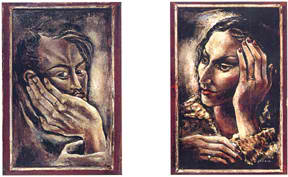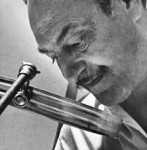
Federico Cantu
Mexican, 1908-1990
Self-Portrait and Portrait of Gloria, 1937
oil on canvas mounted on wood panel
11 5/8 x 7 3/8 in. each
SBMA, Gift of Mrs. MacKinley Helm
1967.35.9-10

Undated photo of Cantú
It is not surprising that Louis Cardoza y Aragon was quoted as saying, “We do not hesitate to name him as one of the most accomplished painters of the new generation in Mexico.”
RESEARCH PAPER
THE ARTIST
Federico Cantu was born in Cadereyta, Mexico on March 3, 1908. As a young boy, he was interested in art, and in 1922 became a student at the Open Air School of Painting in Coyoacan under the tutelage of Alfredo Ramos Martinez. At that point in history, the Open Air School was intent on encouraging the production of a uniquely Mexican art.
Unfortunately for the Open Air School, Cantu was not destined to be an artist who created such work. By the age of 15, Cantu was studying masters in European museums, primarily in France and Spain. He was a student in Jose de Creeft’s sculpture studio and studied the great works of painters such as Botticelli, Picasso, and El Greco. He then spent a few years in the United States, splitting time between Los Angeles and New York, where he accomplished great gallery successes. It would be approximately 10 years before Cantu would return to his native Mexico.
In 1932, Federico was taken on by Diego Rivera to assist on the Ministry of Education project. Cantu mixed paint colors, traced cartoons onto the walls and painted occasional simple passages within the mural. As a professional artist, Cantu went on to paint many religious scenes, nudes, harlequins, portraits, and in his older years, even tried his hand at sculpting. Federico Cantu died in Mexico City in 1989.
THE ART
Cantu’s art was always very European in character, with French, Italian, and Spanish influence more pronounced than Mexican. His work was not fundamentally or uniquely Mexican. This could be attributed to the fact that he spent his most formative years in Europe, developing his personal artistic style. Federico’s work was highly expressive and personal; unlike the muralists, his paintings were not agitated by social problems.
Over the years, Cantu’s work has displayed attributes of his great masters’ influences. He painted many harlequin scenes, which are highly reminiscent of Picasso, and in the late 1920’s spent much of his time creating what many critics called “Botticelli-Cantu’s.” In 1930, Los Angeles Times Reviewer Arthur Miller said that Cantu worked, “With his fingers in the tradition of Giotto, his mind echoing a morbid Botticellian grace, and … an innocence reminiscent of Fra Angelico…” He was truly forging a unique style.
Cantu was a master of line and had an excellent drawing technique. His lines were elegant – supple and winding, marked by curves. In many of Cantu’s paintings, as here, color was used only slightly, for modeling.
DOBLE RETRATO (SELF-PORTRAIT) & DOBLE RETRATO (PORTRAIT OF GLORIA)
The double portraits in our collection, Self-Portrait and Portrait of Gloria, from 1937, show Cantu’s ability to render the human form. The paintings depict the artist and his wife during their first year of marriage. I am tempted to say that these portraits were intended by the artist to commemorate his marriage, being that the figures are modeled in such a way as to ensure that their wedding rings are prominently on display to the viewer. It is impossible to look at this painting and not recognize the union between these two people. The poses of the two figures mirror one another, with the only obvious difference being where they focus their gaze. Cantu looks calmly out at the viewer, while Gloria’s eyes are focused on her husband. Both figures posses dark eyes, sharp features and highly disproportionate, elongated hands. With these hands we are reminded of the elongated figures of El Greco’s Renaissance paintings.
Cantu used a very limited palette for this work, almost entirely crafted out of dark, neutral browns (also reminiscent of El Greco); the only disruption becomes the deep red of Gloria’s nails and lips. Beyond that of the figures, there is no detail in the portraits, nothing in the background to distinguish time or place. Painted in an air of expressionism, the full impact of this painting comes from implied emotion.
Cantu’s sensitivity shines through in these portraits, as both sitters allow us some sort of intimacy. There is a romantic anguish, we can tell, but what we do not know is exactly why. This painting is at the same time very open, and yet still very evasive. For example, both the artist and his wife are leaning their heads in their hands, as if in an act of contemplation. Cantu’s forehead is crinkled, making his face look almost as if he is confused, while Gloria has a calm, serene, if not maybe slightly sad expression. Why is he confused? What is causing her sadness? Cantu has left the audience an opportunity to interpret this timeless portrait.
CONCLUSION
Federico Cantu was not your typical Mexican artist. Although he attended the Open Air School of Painting at a time when they were aiming to create a more ‘Mexican’ art, Cantu’s European influences took over as his source for primary inspiration. Unlike many Mexican artists, he did not lean toward Pre-Columbian influences, and unlike the muralists, he left social unrest out of his work. Do these factors make Cantu any less of a Mexican painter?
In our Doble Retrato (Self-Portrait) and Doble Retrato (Portrait of Gloria), we are given a taste of Cantu’s mastery. We get a strong sense of how old masters techniques appeared in his work – in our case, El Greco – and how he used them as a stepping-stone to creating his own unique style.
Prepared for the Santa Barbara Museum of Art Docent Council by Erin Zetter, February 2004
Bibliography
Cardoza y Aragon, Louis. Federico Cantu: Obra Realizada de 1922 a 1948. Editorial Asbaje-Mexico, MCMXLVIII
Helm, MacKinley. Modern Mexican Painters. Dover Publications, Inc. New York, NY. 1968
Merida, Carlos. Modern Mexican Artists: Critical Notes. Frances Toor Studios, Books for Libraries Press, Freeport, NY. 1968
Andres Blaisten Museum. www.museoblaisten.com. “Federico Cantu Biography”
Miller, Arthur. Los Angeles Times. February 16, 1930; May 9, 1937; November 21, 1948
Devree, Howard. New York Times. May 28, 1939; January 28, 1940; January 26, 1941
SBMA CURATORIAL LABELS
In Self-Portrait and Portrait of Gloria, Federico Cantú renders the human form in an elongated, haunting style reminiscent of Spanish Renaissance master El Greco. The paintings depict the artist and his second wife, Gloria Calero, during their first year of marriage. Both are in contemplative poses with their wedding rings prominently displayed to the viewer. The strong emphasis on line in these works foreshadows Cantú’s turn to engraving in the 1940s. It is not surprising that Louis Cardoza y Aragon was quoted as saying, “We do not hesitate to name him as one of the most accomplished painters of the new generation in Mexico.”
- SBMA title card, 2013
